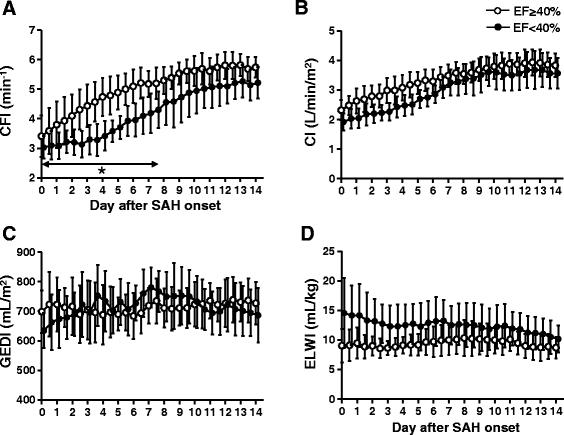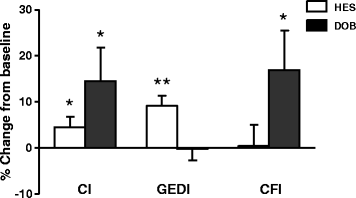Impact of transpulmonary thermodilution-based cardiac contractility and extravascular lung water measurements on clinical outcome of patients with Takotsubo cardiomyopathy after subarachnoid hemorrhage: a retrospective observational study
- PMID: 25113260
- PMCID: PMC4243958
- DOI: 10.1186/s13054-014-0482-4
Impact of transpulmonary thermodilution-based cardiac contractility and extravascular lung water measurements on clinical outcome of patients with Takotsubo cardiomyopathy after subarachnoid hemorrhage: a retrospective observational study
Abstract
Introduction: Takotsubo cardiomyopathy (TCM) is a life-threatening systemic consequence early after subarachnoid hemorrhage (SAH), but precise hemodynamics and related outcome have not been studied. The purpose of this study was to investigate the TCM-induced cardiac function by transpulmonary thermodilution and its impact on clinical outcome of SAH.
Methods: We retrospectively analyzed 46 consecutive postoperative SAH patients who developed TCM. Patients were divided into two groups of echocardiographic left ventricular ejection fraction (LVEF) < 40% (TCM with left ventricular (LV) dysfunction) and LVEF ≥40% (TCM without LV dysfunction). Cardiac function index (CFI) and extravascular lung water index (ELWI) were monitored by transpulmonary thermodilution, in parallel with serial measurements of echocardiographic parameters and blood biochemical markers.
Results: Transpulmonary thermodilution-derived cardiac function index (CFI) was significantly correlated with (LVEF) (r = 0.82, P < 0.0001). The CFI between day 0 to day 7 was significantly lower in patients with LV dysfunction (LVEF <40%) than in patients with LVEF ≥40% (P < 0.05). CFI had a better ability than cardiac output to detect cardiac dysfunction (LVEF < 40%) (area under the curve: 0.85 ± 0.02; P < 0.001). A CFI value of < 4.2 min-1 had a sensitivity of 82% and specificity of 84% for detecting LVEF <40%. The CFI < 4.2 min-1 was associated with delayed cerebral ischemia (DCI) (odds ratio (OR), 2.14; 95% confidence interval (CI), 1.33-2.86; P = 0.004) and poor 3-month functional outcome on modified Rankin Scale of 4-6 (OR, 1.87; 95% CI, 1.06-3.29; P = 0.02). An extravascular lung water index (ELWI) > 14 mL/kg after day 4 increased the risk of poor functional outcome at 3-month follow-up (OR, 2.10; 95% CI, 1.11-3.97; P = 0.04).
Conclusions: Prolonged cardiac dysfunction and pulmonary edema increased the risk of DCI and poor 3-month functional outcome in patients with SAH suffering from TCM. Serial measurements of CFI and ELWI by transpulmonary thermodilution may provide an easy bedside method of detecting early changes of the cardiopulmonary function in directing proper post-SAH treatment.
Figures



Similar articles
-
Serial measurement of extravascular lung water and blood volume during the course of neurogenic pulmonary edema after subarachnoid hemorrhage: initial experience with 3 cases.J Neurosurg Anesthesiol. 2012 Jul;24(3):203-8. doi: 10.1097/ANA.0b013e318242e52e. J Neurosurg Anesthesiol. 2012. PMID: 22193041
-
A multicenter prospective cohort study of volume management after subarachnoid hemorrhage: circulatory characteristics of pulmonary edema after subarachnoid hemorrhage.J Neurosurg. 2016 Aug;125(2):254-63. doi: 10.3171/2015.6.JNS1519. Epub 2015 Nov 27. J Neurosurg. 2016. PMID: 26613172
-
Evaluation of cardiac function index as measured by transpulmonary thermodilution as an indicator of left ventricular ejection fraction in cardiogenic shock.Biomed Res Int. 2014;2014:598029. doi: 10.1155/2014/598029. Epub 2014 Jun 11. Biomed Res Int. 2014. PMID: 25013790 Free PMC article.
-
Transpulmonary Thermodilution-Based Management of Neurogenic Pulmonary Edema After Subarachnoid Hemorrhage.Am J Med Sci. 2015 Nov;350(5):415-9. doi: 10.1097/MAJ.0000000000000561. Am J Med Sci. 2015. PMID: 26517502 Review.
-
Hemodynamic monitoring by transpulmonary thermodilution and pulse contour analysis in critically ill children.Pediatr Crit Care Med. 2011 Jul;12(4):459-66. doi: 10.1097/PCC.0b013e3182070959. Pediatr Crit Care Med. 2011. PMID: 21263372 Review.
Cited by
-
Bioreactance-Based Noninvasive Fluid Responsiveness and Cardiac Output Monitoring: A Pilot Study in Patients with Aneurysmal Subarachnoid Hemorrhage and Literature Review.Crit Care Res Pract. 2020 Sep 15;2020:2748181. doi: 10.1155/2020/2748181. eCollection 2020. Crit Care Res Pract. 2020. PMID: 33014461 Free PMC article.
-
Takotsubo cardiomyopathy in patients suffering from acute non-traumatic subarachnoid hemorrhage-A single center follow-up study.PLoS One. 2022 May 26;17(5):e0268525. doi: 10.1371/journal.pone.0268525. eCollection 2022. PLoS One. 2022. PMID: 35617162 Free PMC article.
-
Intraoperative blood pressure and cardiac complications after aneurysmal subarachnoid hemorrhage: a retrospective cohort study.Int J Surg. 2024 Feb 1;110(2):965-973. doi: 10.1097/JS9.0000000000000928. Int J Surg. 2024. PMID: 38016131 Free PMC article.
-
Noninvasive assessment of fluid responsiveness for emergency abdominal surgery in dogs with pulmonary hypertension: Insights into high-risk companion animal anesthesia.PLoS One. 2020 Oct 23;15(10):e0241234. doi: 10.1371/journal.pone.0241234. eCollection 2020. PLoS One. 2020. PMID: 33095826 Free PMC article.
-
Comparison of cardiac function index derived from femoral and jugular indicator injection for transpulmonary thermodilution with the PiCCO-device: A prospective observational study.PLoS One. 2018 Jul 31;13(7):e0200740. doi: 10.1371/journal.pone.0200740. eCollection 2018. PLoS One. 2018. PMID: 30063736 Free PMC article.
References
Publication types
MeSH terms
Substances
LinkOut - more resources
Full Text Sources
Other Literature Sources
Medical
Miscellaneous

